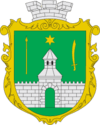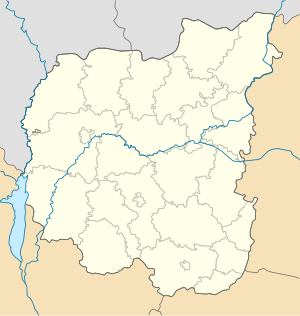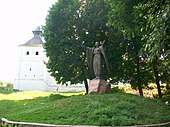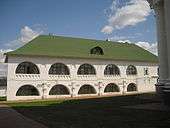Novhorod-Siverskyi
Novhorod-Siverskyi (Ukrainian: Новгород-Сіверський [ˈnɔu̯ɦorod ˈs⁽ʲ⁾iwersʲkɪj]; Polish: Nowogród Siewierski; Russian: Новгород-Северский) is a historic city in Chernihiv Oblast (province) of Ukraine. It is the administrative center of Novhorod-Siverskyi Raion, though it is incorporated as a city of oblast significance and does not belong to the raion. Novhorod-Siverskyi is situated on the bank of the Desna River, 330 km from the capital, Kiev, and 45 km south of the Russian border. Population: 13,031 (2019 est.)[1]
Novhorod-Siverskyi Новгород-Сіверський Nowogród Siewierski • Новгород-Северский | |
|---|---|
Town | |
Merchant's house in Novhorod-Siverskyi | |
 Flag  Coat of arms | |
 Novhorod-Siverskyi Location of Novhorod-Siverskyi in Ukraine  Novhorod-Siverskyi Novhorod-Siverskyi (Ukraine) | |
| Coordinates: 51°59′N 33°16′E | |
| Country | |
| Oblast | |
| Raion | Novhorod-Siverskyi Raion |
| Area | |
| • Total | 11.81 km2 (4.56 sq mi) |
| Population (2018) | |
| • Total | 13,289 |
History
Principality of Novgorod-Seversk 1185–1240
![]()
![]()
![]()
![]()
![]()
![]()
![]()
![]()
![]()
The town was first chronicled in 1044. From 1098 it was the capital of the Siverian Principality, which served as a buffer zone against incursions of the Cumans (Polovtsy) and other steppe peoples. One of the numerous campaigns of local princes against the Cumans produced the great monument of early East Slavic literature, the Tale of Igor's Campaign.
After the town's destruction by Mongols in 1239, it passed to the princes of Bryansk and then to the Grand Dukes of Lithuania. It was ruled by Dymitr Korybut (Kaributas), son of Algirdas. Muscovy obtained the area following the Battle of Vedrosha in 1503, but lost it to Poland after the Time of Troubles. Nowogród Siewierski was granted Magdeburg city rights in 1620 by Polish King Sigismund III Vasa. It was the easternmost powiat (county) seat of Poland. The town passed to Russia as a result of the Russo-Polish War (1654-1667). During the Cossack epoch, it received the status of military company town (sotenne misto) and later regimental town (polkove misto); these were military and administrative divisions in the Cossack army and country. Also Novhorod-Siverskyi became a cultural center of Left-bank Ukraine. It was made the capital of a separate namestnichestvo in 1782–97. Thereafter its importance steadily declined.
During World War II, Novhorod-Siverskyi was occupied by the German Army from 26 August 1941 to 16 September 1943.
Architecture
Despite historic disasters, the town has preserved many architectural monuments, and a branch of the Chernihiv State Historical and Architectural Preserve has been established. The town has managed to keep random planning in its landscape. The boundary of the town historical center is vague. The tourist attractions are located on two high capes divided by ravines: the ensemble of Our Savior and Transfiguration Monastery and the town centre. The architectural monuments of state significance are scattered on five separate areas which compose the territory of the preserve. The biggest area is the territory of Our Savior and Transfiguration Monastery. The other areas are Uspensky (Dormition) Cathedral, the wooden St. Nicolas church, a triumphal arch, and shopping arcades. There are constructions and residential buildings from the 18th and 19th centuries in the town centre. The main point of interest in the town is the former residence of the Chernihiv metropolitans, the monastery of the Saviour's Transfiguration. It features a ponderous Neoclassical cathedral (1791–96, design by Giacomo Quarenghi), seventeenth-century stone walls, and several ecclesiastic foundations dating from the sixteenth century. Other landmarks include the Cossack Baroque Assumption cathedral, a triumphal arch (1787), and the wooden church of St. Nicholas (1760).
Gallery
- Novhorod-Siverskyi. Holy Transfiguration Monastery. View from the walls of the monastery.
- Triumphal Arch
 Monument of Yaroslavna
Monument of Yaroslavna House of seminary
House of seminary- Cathedral of the Assumption
- Alley of Heroes
- Alley of Shevchenko
References
- "Чисельність наявного населення України (Actual population of Ukraine)" (PDF) (in Ukrainian). State Statistics Service of Ukraine. Retrieved 23 May 2020.
External links
| Wikimedia Commons has media related to Novhorod-Siverskyi. |
- Novhorod-Siverskyi on the Official Tourism website of Chernihiv Region (in Ukrainian, nice photographs)
- Some of the sites at Podorozh Ukraïnoyu (in Ukrainian, with pictures)
- Forum (in Russian, city info basically copied from the Wikipedia in Russian)
- The murder of the Jews of Novhorod-Siverskyi during World War II, at Yad Vashem website.